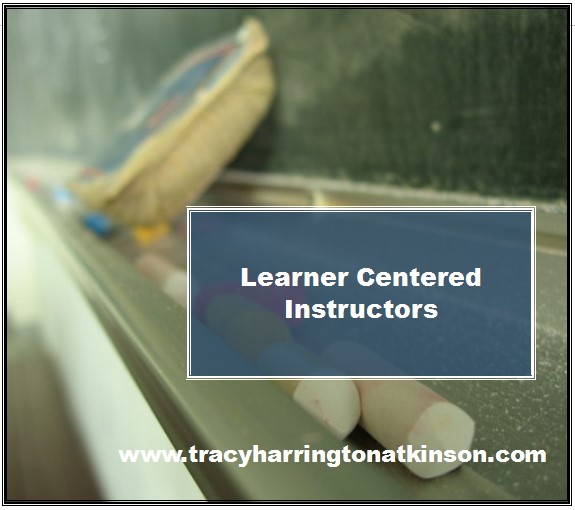 by Tracy Harrington-Atkinson
by Tracy Harrington-Atkinson
Learner centered instructors need to be armed with the knowledge of the characteristics of self-directed learners. Ponton & Carr (2000) lay foundational research determining the three underlying characteristics of autonomous learners. These characteristics include initiative, resourcefulness and persistence which are essential to the successful acquisition of knowledge in any learning environment. Students who possess autonomous learner characteristics also demonstrate greater intrinsic motivation than their counterparts(Salinas, Kane-Johnson & Vasil-Miller, 2008; Smith & Cardaciotto, 2011). Additionally, when these students are introduced to learner centered instructional methods, they construct their own meanings, develop more complex projects than students in traditional sections who are taught through lecture methods and the level of mastery increased (Hawai, 2010).
Knowles (1975) proposed that within the formal classroom, self-directed learning situations require a particular type of environment. He called it a warm learning climate. Such a warm learning climate possesses mutual respect for individual experience and creativity shaping a “warm, mutually respectful, dialogic and mutually trustful” (p. 29) environment. It is conducive to communication where participants may be actively involved.
Teachers need to motivate students to pursue self-directed learning principles to acquire a lifelong learning desire. As a result these tools move the learning from needing extrinsic motivation to relying on intrinsic motivation. This type of motivation helps the learner move from being a reactive recipient of knowledge to a proactive procurer for information. Autonomous learners demonstrate a greater awareness of themselves and their responsibility to contribute to their society and community (Gibbons, 2011).
Whelton (2010) proposes that effective learning centered instructors are like management leaders with specific characteristics. These characteristics include verbal communications including listening, managing time and stress, delegating, and self-awareness. They also possess the ability to manage their individual decisions through recognizing defining and solving problems. These leaders are motivators who influence others through setting goals, articulating a vision, building team spirit and managing conflicts. When educators implement a supportive learning environment, students are given the tools necessary to pursue further acquisition of knowledge throughout their lives (Hawai, 2010; Salinas, Kane-Johnson & Vasil-Miller, 2008).
In implementing classrooms that support the development of learner autonomous characteristics, educators need to use assessment methods that will accurately measure the development of the learners. The most common approaches for autonomous assessment incorporate self-awareness, reflection, metacognition knowledge and even collaborative learning. Despite the current methods being used toward this end, there are several problems. First, autonomy is a multifaceted attainment which has little research conducted on the different stages through which learners progress. Second, trying to determine characteristics of autonomous learners is complex due to the different traits within each stage. Lastly, the greatest problem is related to the assessment itself. The researchers argue that by using assessment methods, the control of the learning situation moves from the learner and back to an authority figure (Ponton & Carr, 2000).
Reinders & White (2011) delve into the possibilities of using technology in assessing the autonomous learner. Technology can be used to achieve some educational goals such as developing the characteristics of learner autonomy as students are given the opportunity to feel empowered in their own learning experience. Researchers noted an additional quality of autonomous learners being about interdependence and less about independence as previously perceived. The weaknesses of technology are evident in the constraints it places upon learners as it can create a sense of over-dependence and even a false sense of development.
Other educational institutions have discovered additional methods to promote learner autonomy while continuing to assess their students. University of Illinois (2010) trains their instructors in the use of different variations of collaborative learning to be used both on campus and in online classrooms. These options are learning contracts, discussions, lectures, self-directed learning, mentorship, small group work, projects, case studies and forums.
Despite the assessment method, educators are are those individuals who coach students to learn from failures and evolve into intrinsically motivated people. They recall that content is used not to simply assimilate information but to define learning skills as students are molded into passionate self-directed learners who are capable of determining their strengths and weaknesses (Weimer, 2002).
Sources:
Gibbons, M. (2008). Motivating students and teaching them to motivate themselves. Retrieved from www.selfdirectedlearning.com/article2.html
Hawai, N. (2010). The exploration of student-centered approaches for the improvement of learning programming in higher education. US China Education Review, 7(9), 47-57.
Knowles, M. (1975). Self-directed learning: a guide for learners and teachers. Parsippany, New Jersey: Globe Fearon Press.
Ponton, M. & Carr, P. (2000). Understanding and promoting autonomy in self-directed learning. Current Research in Social Psychology, 5(19), 34-46
Redding, T. (2010). High self-directed learning: a national imperative in the information age. Retrieved from www.oltraining.com/gld3/HSDL_NI.HTML
Reinders, H. & White, C. (2011). Learner autonomy and new learning environments. Language, Learning & Technology, 15(3), 1-3.
Salinas, M., Kane-Johnson, S. E. & Vasil-Miller, M. A. (2008). Long-term learning, achievement tests and learner centered instruction. Journal of the Scholarship of Teaching and Learning, 8(3), 20-28.
University of Illinois. (2010). Instructional strategies for online courses. Retrieved from www.ion.illinois.edu/resources/tutorials/pedagogy/instructionalstrategies.asp
Weimer, M. (2002). Learner centered teaching: five key changes to practice. San Francisco, California: Jossey Bass.
Whelton, D. (2011). Developing management skills. New Jersey: Prentice Hall.
By Tracy Harrington-Atkinson
Tracy Harrington-Atkinson, mother of six, lives in the Midwest with her husband. She is a teacher, having taught elementary school to higher education, holding degrees in elementary education, a master’s in higher education and continued on to a PhD in curriculum design. She has published several titles, including Calais: The Annals of the Hidden, Rachel’s 8 and Securing Your Tent. She is currently working on a non-fiction text exploring the attributes of self-directed learners: The Five Characteristics of Self-directed Learners.

Comments are closed